UI/UX Design para Jogos: Guia Completo de Interface e Experiência do Usuário
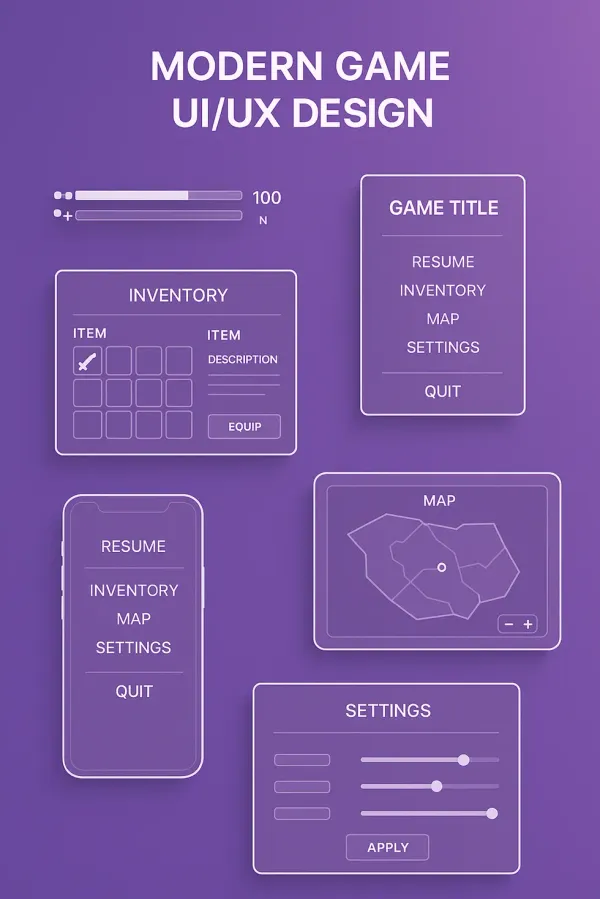
Aprenda UI/UX design para jogos: princípios de usabilidade, HUD design, menus intuitivos e implementação em Godot. Tutorial completo com exemplos.
01/10/2025
Índice do Conteúdo
Artigos Relacionados
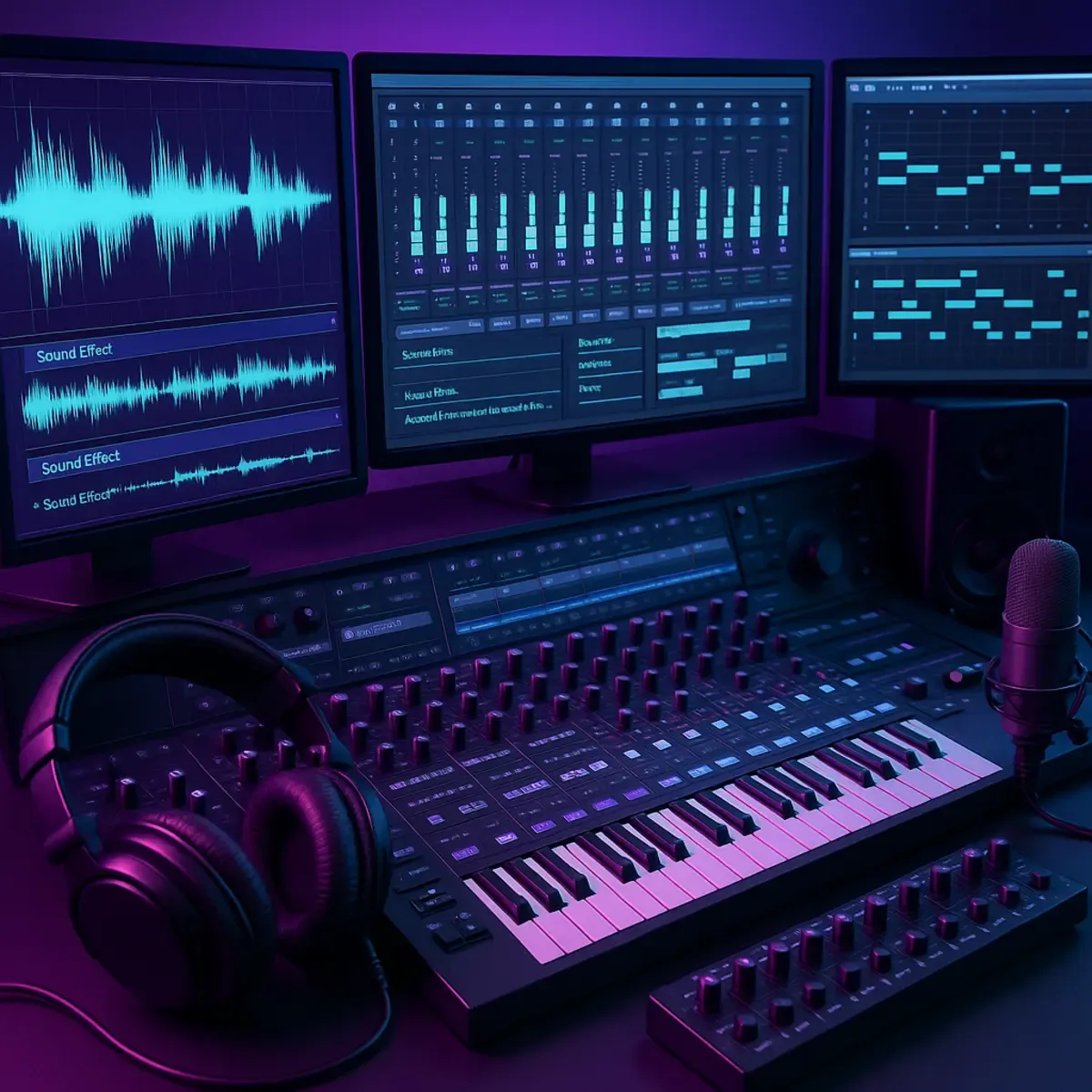
Audio Design para Jogos: Guia Completo de Música e Efeitos Sonoros
01/10/2025
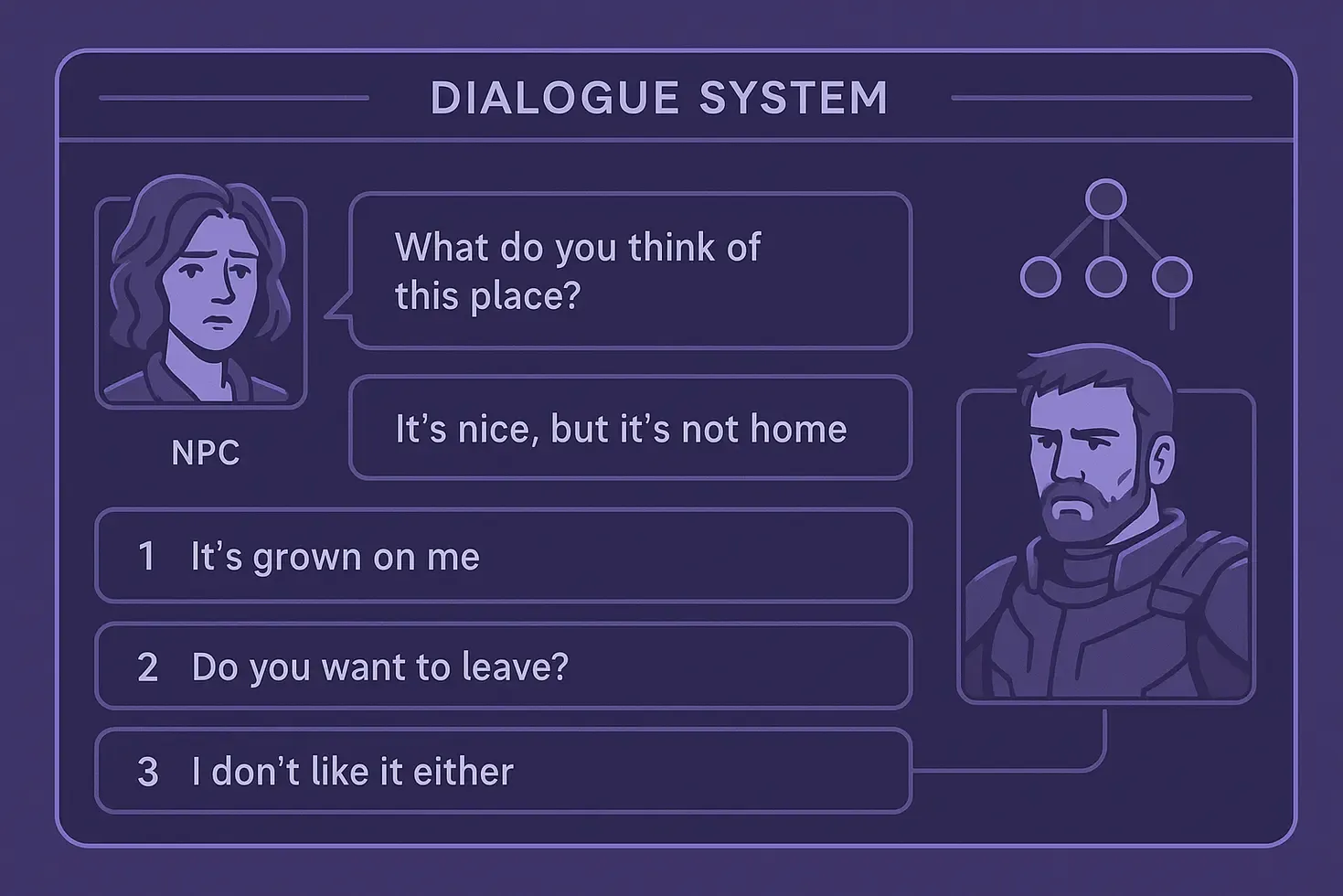
Como Criar um Sistema de Diálogo para Jogos: Tutorial Completo
01/10/2025
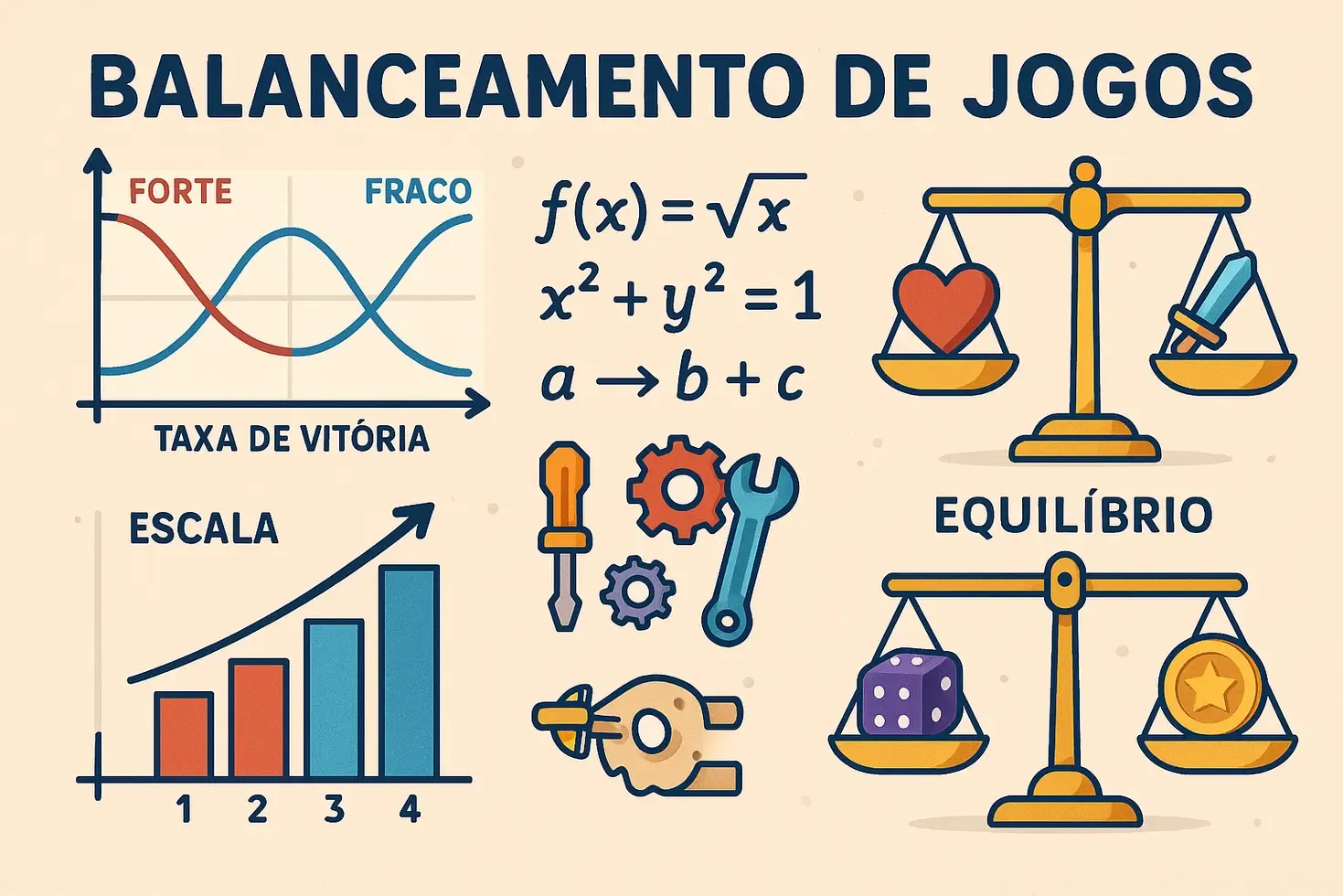
Balanceamento de Jogos: Fórmulas e Técnicas Profissionais
16th Oct 2025
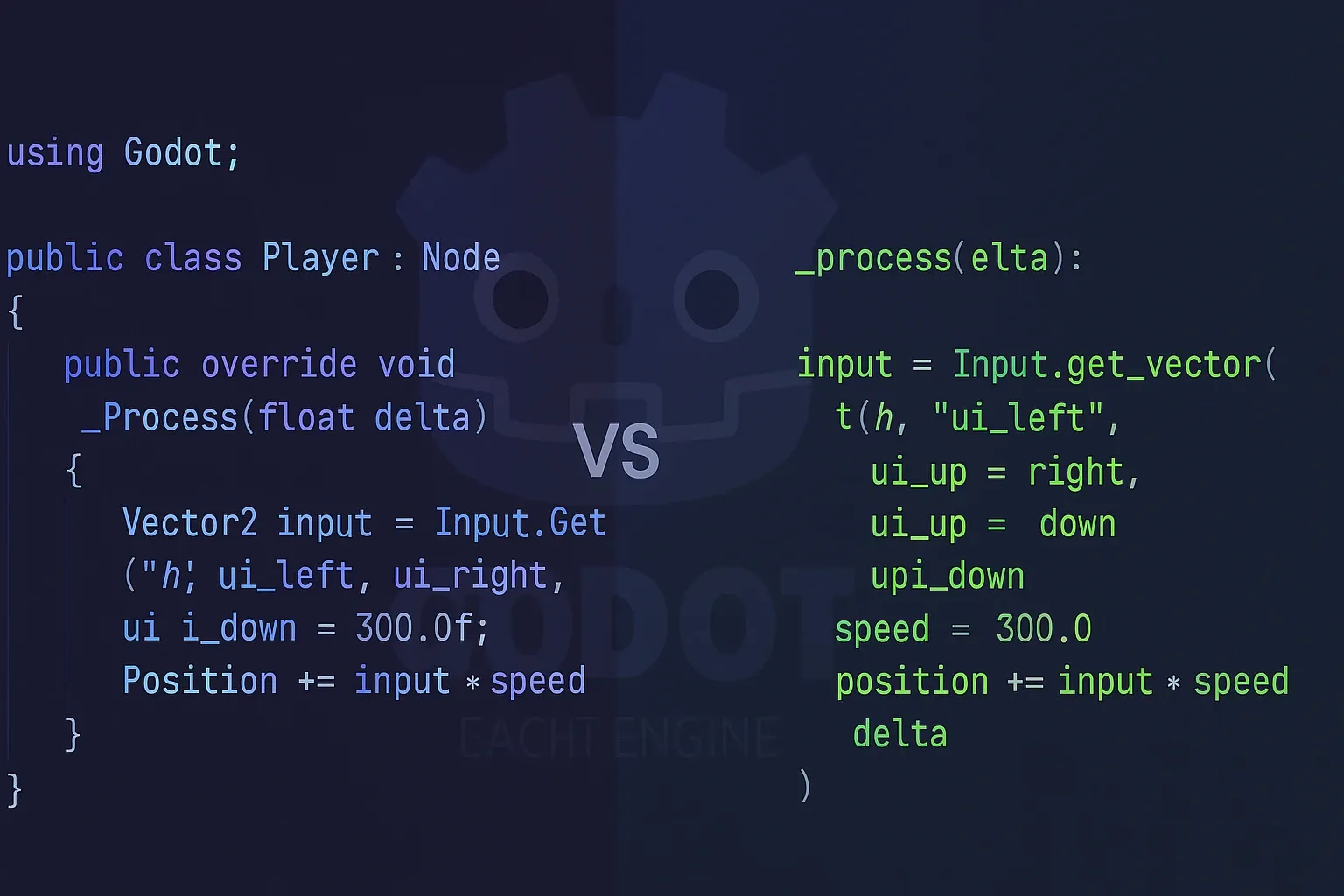
C# vs GDScript no Godot: Qual Linguagem Escolher em 2025?
01/10/2025
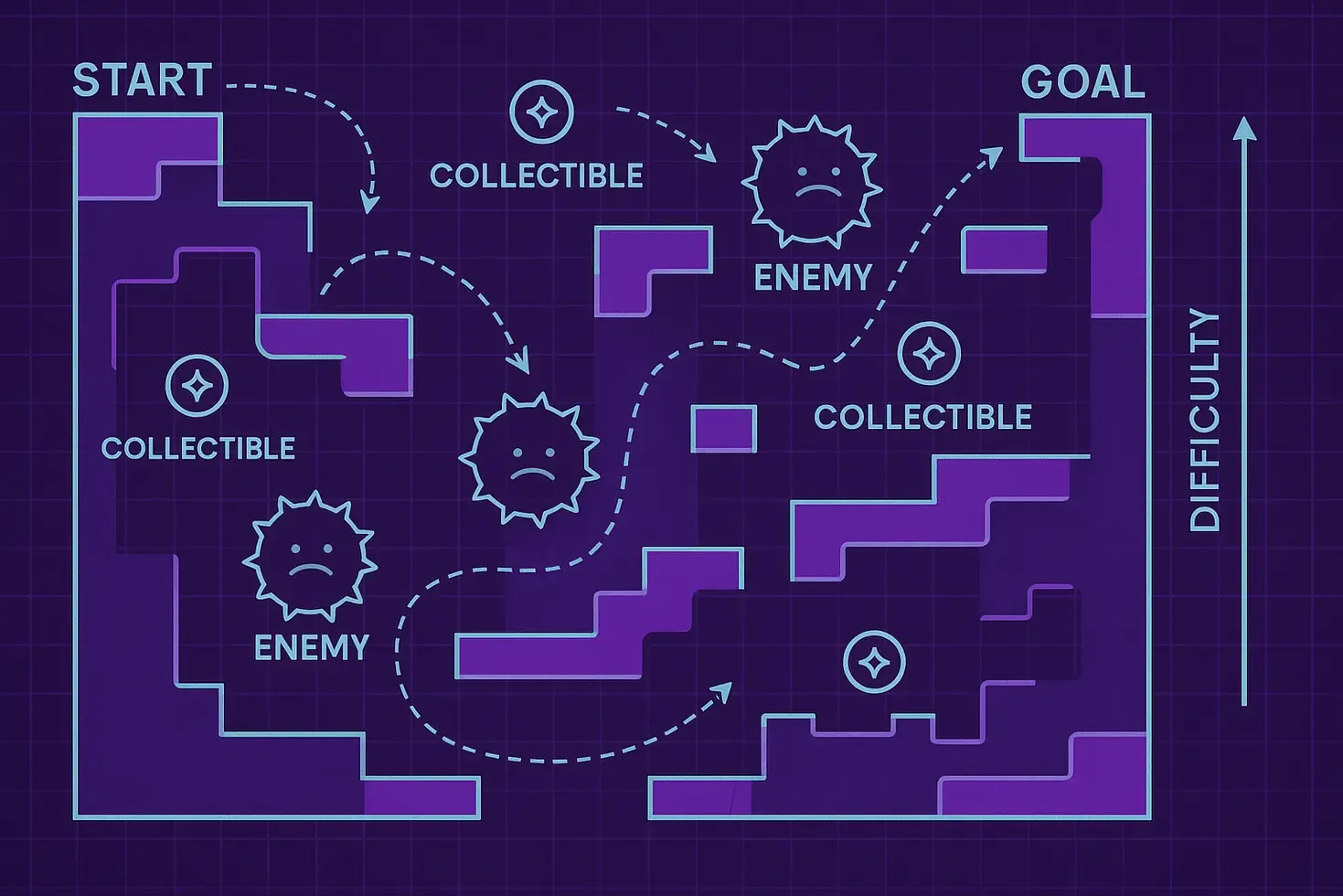
Design de Levels: Princípios e Práticas Para Criar Níveis Memoráveis
01/10/2025
A interface do usuário (UI) e experiência do usuário (UX) são elementos cruciais que podem fazer ou quebrar um jogo. Uma UI bem projetada é invisível - o jogador interage naturalmente sem pensar. Uma UI ruim frustra, confunde e afasta jogadores. Neste guia completo, você aprenderá os princípios fundamentais e técnicas práticas para criar interfaces excepcionais.
Diferença entre UI e UX em Jogos
UI (User Interface): Os elementos visuais que o jogador vê e interage
- HUD (Health, ammo, minimapa)
- Menus (pause, inventário, configurações)
- Prompts e tooltips
- Barras de progresso e indicadores
UX (User Experience): Como o jogador se sente ao interagir com o jogo
- Fluxo de navegação
- Feedback tátil e visual
- Tempo de resposta
- Curva de aprendizado
Bom design de jogos integra ambos perfeitamente.
Princípios Fundamentais de UI/UX
1. Clareza e Legibilidade
Informação crítica deve ser instantaneamente compreensível:
# Sistema de vida com feedback visual claro
extends TextureProgressBar
@export var low_health_threshold: float = 0.3
@export var critical_health_threshold: float = 0.15
@onready var animation_player = $AnimationPlayer
func _ready():
value_changed.connect(_on_health_changed)
func _on_health_changed(new_value: float):
var health_percent = new_value / max_value
# Muda cor baseado em vida
if health_percent <= critical_health_threshold:
modulate = Color.RED
animation_player.play("pulse_critical")
elif health_percent <= low_health_threshold:
modulate = Color.ORANGE
animation_player.play("pulse_low")
else:
modulate = Color.WHITE
animation_player.stop()
func update_health(current: float, maximum: float):
max_value = maximum
value = current
2. Consistência Visual
Mantenha padrões através de toda a UI:
# Sistema de temas UI centralizados
class_name UITheme
extends Resource
@export_group("Colors")
@export var primary_color: Color = Color.hex(0x4A90E2)
@export var secondary_color: Color = Color.hex(0x50E3C2)
@export var danger_color: Color = Color.RED
@export var success_color: Color = Color.GREEN
@export var text_color: Color = Color.WHITE
@export var bg_color: Color = Color(0, 0, 0, 0.7)
@export_group("Fonts")
@export var title_font: Font
@export var body_font: Font
@export var title_size: int = 32
@export var body_size: int = 16
@export_group("Spacing")
@export var padding: int = 16
@export var margin: int = 8
@export var button_height: int = 48
# Aplicar tema a elemento
static func apply_to_button(button: Button, theme: UITheme):
button.add_theme_color_override("font_color", theme.text_color)
button.add_theme_color_override("font_hover_color", theme.primary_color)
button.add_theme_font_override("font", theme.body_font)
button.add_theme_font_size_override("font_size", theme.body_size)
button.custom_minimum_size.y = theme.button_height
3. Feedback Imediato
Toda ação deve ter resposta visual/sonora:
# Botão com feedback completo
extends Button
@export var hover_scale: float = 1.05
@export var press_scale: float = 0.95
@export var animation_duration: float = 0.15
@onready var hover_sound = $HoverSound
@onready var click_sound = $ClickSound
func _ready():
mouse_entered.connect(_on_hover)
mouse_exited.connect(_on_unhover)
button_down.connect(_on_pressed_visual)
button_up.connect(_on_released_visual)
pressed.connect(_on_clicked)
func _on_hover():
hover_sound.play()
var tween = create_tween()
tween.tween_property(self, "scale", Vector2.ONE * hover_scale, animation_duration)
tween.set_ease(Tween.EASE_OUT).set_trans(Tween.TRANS_BACK)
func _on_unhover():
var tween = create_tween()
tween.tween_property(self, "scale", Vector2.ONE, animation_duration)
func _on_pressed_visual():
var tween = create_tween()
tween.tween_property(self, "scale", Vector2.ONE * press_scale, animation_duration * 0.5)
func _on_released_visual():
var tween = create_tween()
tween.tween_property(self, "scale", Vector2.ONE * hover_scale, animation_duration * 0.5)
func _on_clicked():
click_sound.play()
4. Hierarquia Visual
Organize informação por importância:
# HUD com prioridade visual
extends CanvasLayer
@onready var health_bar = $HealthBar # Grande, canto superior esquerdo
@onready var ammo_counter = $AmmoCounter # Médio, canto inferior direito
@onready var score = $Score # Pequeno, topo central
@onready var notifications = $Notifications # Temporário, centro-baixo
func _ready():
# Saúde é crítica - sempre visível e grande
health_bar.scale = Vector2(1.2, 1.2)
# Munição é importante mas não crítica
ammo_counter.modulate.a = 0.9
# Score é informativo - discreto
score.modulate.a = 0.7
score.scale = Vector2(0.8, 0.8)
# Notificações temporárias não obstruem gameplay
func show_notification(text: String, duration: float = 3.0):
var label = Label.new()
label.text = text
label.add_theme_font_size_override("font_size", 24)
notifications.add_child(label)
# Fade in
label.modulate.a = 0
var tween = create_tween()
tween.tween_property(label, "modulate:a", 1.0, 0.3)
# Espera
await get_tree().create_timer(duration).timeout
# Fade out e remove
tween = create_tween()
tween.tween_property(label, "modulate:a", 0.0, 0.3)
await tween.finished
label.queue_free()
HUD Design
Minimalismo vs Informação
O HUD ideal mostra apenas informação necessária no momento:
# HUD contextual que aparece quando necessário
extends Control
@onready var interaction_prompt = $InteractionPrompt
@onready var objective_marker = $ObjectiveMarker
@onready var tutorial_hint = $TutorialHint
var nearby_interactable: Node = null
func _ready():
# Esconde tudo inicialmente
interaction_prompt.hide()
objective_marker.hide()
tutorial_hint.hide()
func _process(_delta):
# Mostra prompt apenas quando há algo para interagir
if nearby_interactable:
interaction_prompt.show()
interaction_prompt.text = "[E] " + nearby_interactable.interaction_text
else:
interaction_prompt.hide()
# Chamado por Area2D quando jogador está próximo
func set_nearby_interactable(interactable: Node):
nearby_interactable = interactable
func clear_nearby_interactable():
nearby_interactable = null
# Sistema de objetivos que se esconde após alguns segundos
func show_objective(text: String, auto_hide: bool = true):
objective_marker.text = text
objective_marker.show()
if auto_hide:
await get_tree().create_timer(5.0).timeout
hide_objective()
func hide_objective():
var tween = create_tween()
tween.tween_property(objective_marker, "modulate:a", 0.0, 0.5)
await tween.finished
objective_marker.hide()
objective_marker.modulate.a = 1.0
Diegetic UI
UI que existe dentro do mundo do jogo:
# Vida mostrada na própria personagem (sem barra de HP)
extends CharacterBody2D
@onready var damage_flash = $Sprite2D
@onready var blood_particles = $BloodParticles
var max_health: float = 100.0
var current_health: float = 100.0
func take_damage(amount: float):
current_health -= amount
# Feedback visual no personagem
damage_flash.modulate = Color.RED
var tween = create_tween()
tween.tween_property(damage_flash, "modulate", Color.WHITE, 0.3)
# Partículas de sangue
blood_particles.emitting = true
# Tela vermelha nas bordas quando vida baixa
if current_health / max_health < 0.3:
apply_vignette_effect()
if current_health <= 0:
die()
func apply_vignette_effect():
var vignette = get_node("/root/MainScene/VignetteEffect")
var intensity = 1.0 - (current_health / max_health)
vignette.modulate = Color(1, 0, 0, intensity * 0.5)
Spatial UI (UI 3D)
Para jogos VR ou third-person:
# UI flutuante sobre personagem
extends Node3D
@onready var health_bar_3d = $Viewport/HealthBar
@onready var name_label = $Viewport/NameLabel
@onready var sprite_3d = $Sprite3D
func _ready():
# Configura billboard para sempre olhar para câmera
sprite_3d.billboard = BaseMaterial3D.BILLBOARD_ENABLED
func _process(_delta):
# Sempre voltado para câmera
var camera = get_viewport().get_camera_3d()
if camera:
look_at(camera.global_position, Vector3.UP)
Sistema de Menus
Menu Principal
extends Control
@onready var buttons_container = $VBoxContainer
@onready var title = $Title
@onready var background = $Background
var button_scene = preload("res://ui/menu_button.tscn")
func _ready():
create_menu_buttons()
animate_intro()
func create_menu_buttons():
var buttons = [
{"text": "Novo Jogo", "action": start_new_game},
{"text": "Continuar", "action": continue_game},
{"text": "Configurações", "action": open_settings},
{"text": "Créditos", "action": show_credits},
{"text": "Sair", "action": quit_game}
]
for i in buttons.size():
var button = button_scene.instantiate()
button.text = buttons[i].text
button.pressed.connect(buttons[i].action)
buttons_container.add_child(button)
# Animação escalonada
button.modulate.a = 0
button.position.x = -100
await get_tree().create_timer(0.1).timeout
var tween = create_tween().set_parallel(true)
tween.tween_property(button, "modulate:a", 1.0, 0.3)
tween.tween_property(button, "position:x", 0, 0.3).set_trans(Tween.TRANS_BACK)
func animate_intro():
title.scale = Vector2.ZERO
var tween = create_tween()
tween.tween_property(title, "scale", Vector2.ONE, 0.5).set_trans(Tween.TRANS_ELASTIC)
func start_new_game():
get_tree().change_scene_to_file("res://scenes/game.tscn")
func continue_game():
SaveSystem.load_game()
func open_settings():
get_tree().change_scene_to_file("res://ui/settings_menu.tscn")
func show_credits():
get_tree().change_scene_to_file("res://ui/credits.tscn")
func quit_game():
get_tree().quit()
Menu de Pausa
extends Control
var is_paused: bool = false
func _ready():
hide()
process_mode = Node.PROCESS_MODE_ALWAYS # Funciona mesmo quando pausado
func _input(event):
if event.is_action_pressed("ui_cancel"):
toggle_pause()
func toggle_pause():
is_paused = !is_paused
get_tree().paused = is_paused
visible = is_paused
if is_paused:
animate_in()
else:
animate_out()
func animate_in():
scale = Vector2(0.8, 0.8)
modulate.a = 0
var tween = create_tween().set_parallel(true)
tween.tween_property(self, "scale", Vector2.ONE, 0.3).set_trans(Tween.TRANS_BACK)
tween.tween_property(self, "modulate:a", 1.0, 0.2)
func animate_out():
var tween = create_tween()
tween.tween_property(self, "modulate:a", 0.0, 0.2)
await tween.finished
hide()
func _on_resume_pressed():
toggle_pause()
func _on_settings_pressed():
# Abre menu configurações sem fechar pause
var settings = preload("res://ui/settings_menu.tscn").instantiate()
add_child(settings)
func _on_quit_pressed():
get_tree().paused = false
get_tree().change_scene_to_file("res://ui/main_menu.tscn")
Descubra Sua Área Ideal no Game Dev
UI/UX design, programação ou arte? Nosso teste vocacional identifica suas fortalezas e recomenda o melhor caminho de carreira.
Acessibilidade em UI
Tamanho de Texto Ajustável
class_name AccessibilitySettings
extends Node
enum TextSize { SMALL, MEDIUM, LARGE, EXTRA_LARGE }
var current_text_size: TextSize = TextSize.MEDIUM
var text_size_multipliers = {
TextSize.SMALL: 0.8,
TextSize.MEDIUM: 1.0,
TextSize.LARGE: 1.3,
TextSize.EXTRA_LARGE: 1.6
}
func set_text_size(size: TextSize):
current_text_size = size
apply_to_all_labels()
func apply_to_all_labels():
var multiplier = text_size_multipliers[current_text_size]
for label in get_tree().get_nodes_in_group("scalable_text"):
if label is Label or label is RichTextLabel:
var base_size = label.get_meta("base_font_size", 16)
label.add_theme_font_size_override("font_size", int(base_size * multiplier))
Modos de Contraste
# High contrast mode para deficiência visual
class_name ContrastMode
extends Node
var high_contrast_enabled: bool = false
func toggle_high_contrast():
high_contrast_enabled = !high_contrast_enabled
apply_contrast_mode()
func apply_contrast_mode():
if high_contrast_enabled:
# Cores de alto contraste
RenderingServer.set_default_clear_color(Color.BLACK)
for ui_element in get_tree().get_nodes_in_group("ui_elements"):
if ui_element is Control:
ui_element.modulate = Color.WHITE
# Aumenta outline/bordas
if ui_element.has_meta("outline"):
ui_element.get_meta("outline").width = 3
else:
# Restaura cores normais
RenderingServer.set_default_clear_color(Color(0.1, 0.1, 0.1))
for ui_element in get_tree().get_nodes_in_group("ui_elements"):
if ui_element is Control:
ui_element.modulate = Color.WHITE
Colorblind Mode
# Paleta alternativa para daltonismo
enum ColorblindType { NONE, PROTANOPIA, DEUTERANOPIA, TRITANOPIA }
var colorblind_mode: ColorblindType = ColorblindType.NONE
func apply_colorblind_filter(type: ColorblindType):
var shader_material = ShaderMaterial.new()
match type:
ColorblindType.PROTANOPIA:
shader_material.shader = preload("res://shaders/protanopia.gdshader")
ColorblindType.DEUTERANOPIA:
shader_material.shader = preload("res://shaders/deuteranopia.gdshader")
ColorblindType.TRITANOPIA:
shader_material.shader = preload("res://shaders/tritanopia.gdshader")
ColorblindType.NONE:
shader_material = null
get_viewport().set_canvas_cull_mask(shader_material)
Animações e Transições
Page Transitions
# Gerenciador de transições entre telas
class_name SceneTransition
extends CanvasLayer
@onready var animation_player = $AnimationPlayer
@onready var color_rect = $ColorRect
func change_scene(target_scene: String, transition_type: String = "fade"):
match transition_type:
"fade":
await fade_transition(target_scene)
"slide":
await slide_transition(target_scene)
"wipe":
await wipe_transition(target_scene)
func fade_transition(target_scene: String):
animation_player.play("fade_out")
await animation_player.animation_finished
get_tree().change_scene_to_file(target_scene)
animation_player.play("fade_in")
await animation_player.animation_finished
func slide_transition(target_scene: String):
var tween = create_tween()
tween.tween_property(color_rect, "position:x", 0, 0.5).from(-1920)
await tween.finished
get_tree().change_scene_to_file(target_scene)
tween = create_tween()
tween.tween_property(color_rect, "position:x", 1920, 0.5)
Micro-animations
Pequenas animações que dão vida à UI:
# Ícone de moeda que anima ao ganhar dinheiro
extends TextureRect
func add_coins(amount: int):
# Bounce animation
var tween = create_tween()
tween.tween_property(self, "scale", Vector2(1.3, 1.3), 0.1)
tween.tween_property(self, "scale", Vector2.ONE, 0.2).set_trans(Tween.TRANS_ELASTIC)
# Particle effect
$CoinParticles.emitting = true
# Update value with counting animation
await count_up_animation(amount)
func count_up_animation(target: int):
var current = 0
var duration = 0.5
var steps = 20
for i in steps:
current = lerp(0, target, float(i) / steps)
$CoinLabel.text = str(int(current))
await get_tree().create_timer(duration / steps).timeout
$CoinLabel.text = str(target)
Responsive Design
Sistema de Ancoragem
# Layout que se adapta a diferentes resoluções
extends Control
func _ready():
get_viewport().size_changed.connect(_on_viewport_resized)
_on_viewport_resized()
func _on_viewport_resized():
var viewport_size = get_viewport_rect().size
# Mobile (portrait)
if viewport_size.x < viewport_size.y:
apply_mobile_layout()
# Desktop/Landscape
else:
apply_desktop_layout()
func apply_mobile_layout():
# Stack elementos verticalmente
$HealthBar.position = Vector2(20, 20)
$HealthBar.size = Vector2(200, 30)
$AmmoCounter.position = Vector2(20, 70)
$AmmoCounter.size = Vector2(150, 40)
func apply_desktop_layout():
# Espalha elementos pelos cantos
$HealthBar.position = Vector2(20, 20)
$HealthBar.size = Vector2(300, 40)
var viewport_size = get_viewport_rect().size
$AmmoCounter.position = Vector2(viewport_size.x - 170, viewport_size.y - 60)
Safe Zones
Garanta que UI importante fique visível:
# Respeita notch e bordas de telas móveis
func _ready():
var safe_area = DisplayServer.get_display_safe_area()
# Aplica margem baseada em safe area
add_theme_constant_override("margin_top", safe_area.position.y)
add_theme_constant_override("margin_left", safe_area.position.x)
add_theme_constant_override("margin_bottom",
get_viewport_rect().size.y - safe_area.end.y)
add_theme_constant_override("margin_right",
get_viewport_rect().size.x - safe_area.end.x)
Tooltips e Tutoriais
Sistema de Tooltips
class_name Tooltip
extends Control
@onready var label = $Panel/Label
@onready var panel = $Panel
var target: Control = null
var offset: Vector2 = Vector2(10, 10)
func _ready():
hide()
func show_tooltip(text: String, target_control: Control):
target = target_control
label.text = text
# Ajusta tamanho ao texto
panel.custom_minimum_size = label.size + Vector2(20, 20)
show()
position_tooltip()
func position_tooltip():
if not target:
return
var target_pos = target.global_position
var tooltip_pos = target_pos + offset
# Garante que tooltip fica na tela
var viewport_size = get_viewport_rect().size
if tooltip_pos.x + panel.size.x > viewport_size.x:
tooltip_pos.x = target_pos.x - panel.size.x - offset.x
if tooltip_pos.y + panel.size.y > viewport_size.y:
tooltip_pos.y = target_pos.y - panel.size.y - offset.y
global_position = tooltip_pos
func hide_tooltip():
hide()
target = null
Tutorial Interativo
# Sistema de tutorial passo-a-passo
class_name TutorialSystem
extends Node
signal tutorial_completed()
var current_step: int = 0
var tutorial_steps: Array = []
func start_tutorial(steps: Array):
tutorial_steps = steps
current_step = 0
show_current_step()
func show_current_step():
if current_step >= tutorial_steps.size():
tutorial_completed.emit()
return
var step = tutorial_steps[current_step]
# Highlight elemento
if step.has("target"):
highlight_element(step.target)
# Mostra mensagem
show_tutorial_message(step.message, step.get("position", Vector2.ZERO))
# Espera ação do jogador
if step.has("wait_for_action"):
await wait_for_action(step.wait_for_action)
next_step()
func next_step():
current_step += 1
show_current_step()
func highlight_element(element: Control):
# Overlay escuro exceto no elemento
var overlay = ColorRect.new()
overlay.color = Color(0, 0, 0, 0.7)
overlay.set_anchors_preset(Control.PRESET_FULL_RECT)
get_tree().root.add_child(overlay)
# Recorte para mostrar elemento
# (implementação simplificada)
overlay.mouse_filter = Control.MOUSE_FILTER_IGNORE
Transforme Jogadores em Fãs com UI/UX Excepcional
Aprenda a criar interfaces profissionais que engajam e retêm jogadores. Curso completo de game design com foco em UX.
Performance de UI
Otimização de Draw Calls
# Use CanvasGroup para reduzir draw calls
extends CanvasGroup
func _ready():
# Agrupa todos os filhos em uma única draw call
set_process_mode(Node.PROCESS_MODE_INHERIT)
# Ativa batching
use_mipmaps = true
Lazy Loading de Menus
# Carrega menus apenas quando necessário
class_name MenuManager
extends Node
var loaded_menus: Dictionary = {}
func show_menu(menu_path: String):
if not loaded_menus.has(menu_path):
var menu = load(menu_path).instantiate()
add_child(menu)
menu.hide()
loaded_menus[menu_path] = menu
# Esconde todos, mostra apenas o solicitado
for menu in loaded_menus.values():
menu.hide()
loaded_menus[menu_path].show()
Conclusão
UI/UX design excepcional é invisível mas essencial. Ao aplicar os princípios de clareza, consistência, feedback e acessibilidade, você cria experiências intuitivas que mantêm jogadores imersos e engajados.
Lembre-se: teste sua UI com jogadores reais. O que parece óbvio para você pode ser confuso para outros. Itere, observe e melhore constantemente.
Próximos Passos:
- Audite a UI atual do seu jogo
- Implemente sistema de feedback em todos os botões
- Adicione ao menos 2 opções de acessibilidade
- Teste com diferentes resoluções
- Colete feedback de playtesters sobre usabilidade
Boa UI é boa jogabilidade!
Índice do Conteúdo
Artigos Relacionados

Audio Design para Jogos: Guia Completo de Música e Efeitos Sonoros
01/10/2025

Como Criar um Sistema de Diálogo para Jogos: Tutorial Completo
01/10/2025

Balanceamento de Jogos: Fórmulas e Técnicas Profissionais
16th Oct 2025

C# vs GDScript no Godot: Qual Linguagem Escolher em 2025?
01/10/2025

Design de Levels: Princípios e Práticas Para Criar Níveis Memoráveis
01/10/2025